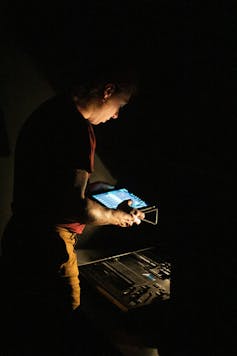Source: Radio New Zealand
Explainer – Whether it’s a Metallica concert, the Santa Parade or, yes, even the much-hyped opening of IKEA, Auckland Transport Operation Centre is tasked with trying to keep people moving.
It looks a little bit like NASA’s Mission Control, with dozens of monitors and computer screens all humming away with eyes on a city of more than 1.5 million people every busy day.
Nestled amongst the cafes and offices of Auckland’s North Shore, the Auckland Transport Operation Centre – ATOC for short – is the nerve centre of a massive network of roads, bus schedules, intersections and stop signs throughout much of the North Island. Between Christmas shopping and holiday road trips, it’s entering one of the busiest times of the year.
Here’s a look at how exactly it all works.
Claire Howard is the manager at Auckland Transport Operation Centre (ATOC). RNZ / Nik Dirga
What exactly does ATOC do?
The centre is run in a partnership by Auckland Transport and NZTA and operates Auckland as what’s called “one network” – responsible for managing local roads, state highways, bus and ferry travel, as well as train travel, which is handled from a separate location.
It covers state highways from Taupō to Cape Reinga, while a sister centre in Wellington covers from Tūrangi to Invercargill.
Between them, the two centres cover approximately 11,000 km of state highways.
Claire Howard has been managing the Auckland centre for the past year and a half, and previously put in many years on the “shop floor” there.
“The network is like the arteries in your body – they’re all connected,” she said.
“We have a kind of ethos that we want to get our customers from A to B, and travel as quickly and efficiently as possible, regardless of who operates that part of the network.”
What this means is a constantly churning surveillance network across CCTV and other trackers keeping an eye on motorways, bus stops, and much more.
And it never truly shuts down.
“Twenty-four seven every day of the year,” said Zane Davidson, real-time operations manager. “You can kind of get a sense here just standing back and appreciating the amount of activity going on.”
The team deals with morning peak and evening rush hour peak traffic, and the increasingly short period of time in between called “interpeak”.
The main control room is split up into sections – one area covering the bus network, one the motorways, while others monitor local roads and incidents. Those flashing electronic billboards you see around the city alerting you to wet weather or heavy winds? Those are all controlled here.
Auckland Transport Operation Centre monitors traffic from Tāupo to Cape Reinga. RNZ/Calvin Samuel
ATOC by the numbers
- Responsible for managing traffic across 3000km of state highways from Taupō to Cape Reinga and 7500km of arterial and local roads across Auckland
- Staff are on duty 24 hours a day, 7 days a week
- More than 5000 CCTV cameras keep watch
- 16,000 traffic signal adjustments are made each month
- The centre also manages traffic control for around 70 planned events a year
- They also deal with more than 40,000 “unplanned” events – accidents, weather chaos, breakdowns and the like
Auckland Transport Operation Centre is staffed 24 hours a day, 7 days a week. RNZ/Calvin Samuel
So they control the traffic lights and on-ramp signals here?
They do, but the majority of the work is automated now, with frequent real-time adjustments made by ATOC staff based on traffic flow or incidents.
“The ramp signal network is pretty much now fully automated,” said principal signal engineer Mitch Tse. “We have detectors on the network, particularly on the state highway or motorway network, collecting data constantly.”
“That historical data is built up over time and we’ve got algorithms that we set up and parameters that we set up to essentially maintain or protect the state highway network to keep traffic and our customers moving. They’ll come on automatically as they see if there’s a flow breakdown … and then the operators can manually override.”
Traffic lights are run by a system called SCATS, first developed in Sydney and now used around the world.
Simply put, the system uses detectors in the road that can detect vehicles approaching intersections, as well as the volume of vehicles and time between their movements. Nearby intersections can be linked with each other and coordinate the broader traffic picture in the area, and a central manager analyses the broader region and makes adjustments.
“We’ve got vehicle sensors on the approach or at the limit lines, and they’re constantly collecting data,” Tse said.
“It can determine how much time is given to each approach, depending on demand.”
At any time the system can be accessed and manually altered by operators if needed.
How the SCATS system works:
[embedded content]
Tse said it’s important to consider protecting the entire traffic corridor when incidents happen. Looking at the big picture when managing traffic jams may not cheer up the person in their Corolla stuck in the middle of it all, but a broader approach is key with so many moving parts.
“In terms of our intervention, it’s going to be a calculated one, so that we know we’re protecting or monitoring the entire corridor instead of one intersection,” he said.
There’s also a balance between day to day activity on the traffic network and planning ahead for the future.
Zane Davidson, real-time operations manager at Auckland Transport Operation Centre (ATOC). RNZ / Nik Dirga
What about emergency incidents?
One of the big jobs at ATOC is looking for problems on the road network, which can range from a car broken down in the Waterview Tunnel to a major accident.
“Seconds mean a lot to us,” Howard said. “The sooner that we can find it and for the event to be identified, the sooner we can do something about it and we can get the right resources to the site. The sooner that it can be cleared and we can put the traffic back to normal for that time of day.”
There are more than 100 incidents a day on average which ATOC deals with, frequently in partnership with other agencies such as Fire and Emergency New Zealand. There’s also a NZ Police officer on duty to monitor events.
“It’ll range from a vehicle stopped, which might have a minor impact for a limited time, all the way through to a serious crash or damage to an asset,” Davidson said.
For instance, on the day RNZ visited ATOC, a roadworks equipment breakdown on the Harbour Bridge led to multiple lane closures during early morning rush hour.
When that happens, AT and NZTA put out communications as quickly as possible on their journey planner apps and social media to notify drivers of delays.
During weather events, things can get pretty hectic. ATOC has an incident planning room which is put into action when an event rises beyond “BAU” – “business as usual” in AT lingo.
“When it goes above a business as usual then we stand up an incident management team,” Howard said.
Electronic billboards around Auckland are controlled at Auckland Transport Operations Centre. RNZ / Nik Dirga
Their systems keep track of faults and prioritise them by urgency, and ATOC staff are in constant communication with each other in person and over their communications networks.
“At any one time we can have upwards of 10 things going on at once,” Davidson said.
“The team’s so good at just triaging and prioritising and just working through things quite methodically now. It’s quite hard to panic them.
“These guys respond to hundreds of events every single day,” Howard said. “Some of them you know about, some of them you will never know about.”
Tse said it’s important to consider protecting the entire traffic corridor when incidents happen.
“In terms of our intervention, it’s going to be a calculated one, so that we know we’re protecting or monitoring the entire corridor instead of one intersection.”
ATOC also frequently undergoes planning for events on the scale of Cyclone Gabrielle and the 2023 Anniversary Weekend floods in Auckland.
“We learned a lot from Gabrielle and the cyclones and the Auckland floods,” Howard said. “We learned a heck of a lot and we’ve done a lot to mitigate and reduce some of that impact.”
Davidson said simulations are run several times a year of possible scenarios, from another cyclone event on down.
November’s Metallica concert drew thousands to Eden Park. Tom Grut
And what about planned events?
ATOC also handles the planning for upwards of 70 events a year that might require road closures or traffic management – and that can range from the opening of IKEA to the recent Metallica concert at Eden Park.
Each event carries its own unique traffic patterns which factors into planning, Davidson said.
“It’s understanding what people are trying to do when they are attending these concerts,” he said. “You’ve got a very different audience depending on what you’re going to see. … The transport demands are different.
“A Metallica audience might attract people from Hamilton, for example, whereas something more local like the All Blacks might not necessarily to the same degree.”
Up to 120,000 vehicles an hour can travel on some of the busiest roads. RNZ / Nicky Park
I still get stuck in traffic all the time, though. Can’t that be fixed?
Realistically, that can’t happen unless many people stop using their cars. AT estimates there’s up to 120,000 vehicles per hour on some of Auckland’s arterial roads.
Increased use of public transport and projects like the enormous Auckland City Rail Link – not expected to open until later in 2026 – may help.
“We’ll always have some sort of congestion somewhere on the network,” Howard said.
Traffic can be costly in many ways – a report commissioned by Mayor Wayne Brown released earlier this year estimated traffic congestion could cost the super city $2.6 billion each year by next year.
The report, “Auckland’s Cost of Congestion”, estimated the average Aucklander could waste more than 17 hours in traffic each year by 2026 – working out to 29 million hours every year across the city.
Brown supports introducing some form of congestion charging to Auckland, as has been seen in other cities around the world.
A major shake-up of Auckland Transport announced by the government for next year could affect ATOC operations. A new Auckland Regional Transport Committee will make policy and planning decisions.
Auckland Council said it is too early to be definitive on how the transport reform might affect existing programs like ATOC. The Transport Reform Bill is not expected to be finalised until March.
“The council and AT are currently focused on making decisions on the functions and activity that will sit with the new council-controlled organisation and what will transfer to the council,” said Megan Tyler, the council’s director of policy, planning and governance. “However, decisions on this have not yet been made.”
ATOC has a team of traffic engineers whom Howard said are always looking at “how is this route operating over a certain amount of time?”
“And do we need to make permanent changes because there’s more demand? And that could be maybe a new school is opened up or a shopping centre has opened up. What do we need to do to change that?”
Howard said that some responsibility falls on drivers as well to avoid congestion – witness repeated warnings about congestion around Mount Wellington with IKEA’s opening this week.
“One of the things I would love is for people to plan ahead for anything. I think we’ve gone past the days where you can jump in the car and think you’ll always get a free rein through to wherever you want to go.
“If you are travelling around, whether it’s for your Christmas shopping, whether it’s for your holidays, plan ahead, plan for those delays, use navigation apps that are out there, so you’re prepared.”
Screens are constantly buzzing monitoring the motorways and roads at Auckland Transport Operation Centre. RNZ/Calvin Samuel
Ultimately, how much can traffic management do?
Nobody is ever happy when they get stuck in traffic jams, but go back again to the analogy at the start of this article – the network is like a giant circulatory system, and all the pieces have to work together to keep it moving.
Howard said that constantly growing Auckland creates its own challenges.
This is why you’ll see things like the dynamic lane changes, such as ones recently installed on Maioro Road in New Windsor, which can change the direction of traffic lanes at peak times of the day.
“We don’t have a lot of space in Auckland to build nice brand new roads and keep people moving everywhere. … We’ve got to do things a little bit more intelligently and differently.”
“If we weren’t here, you would definitely notice. The congestion would be worse, you would be less informed, you wouldn’t understand what’s going on the network …. it would just be a lot worse if these teams weren’t here 24-7 operating the network.”
Sign up for Ngā Pitopito Kōrero, a daily newsletter curated by our editors and delivered straight to your inbox every weekday.
– Published by EveningReport.nz and AsiaPacificReport.nz, see: MIL OSI in partnership with Radio New Zealand




















